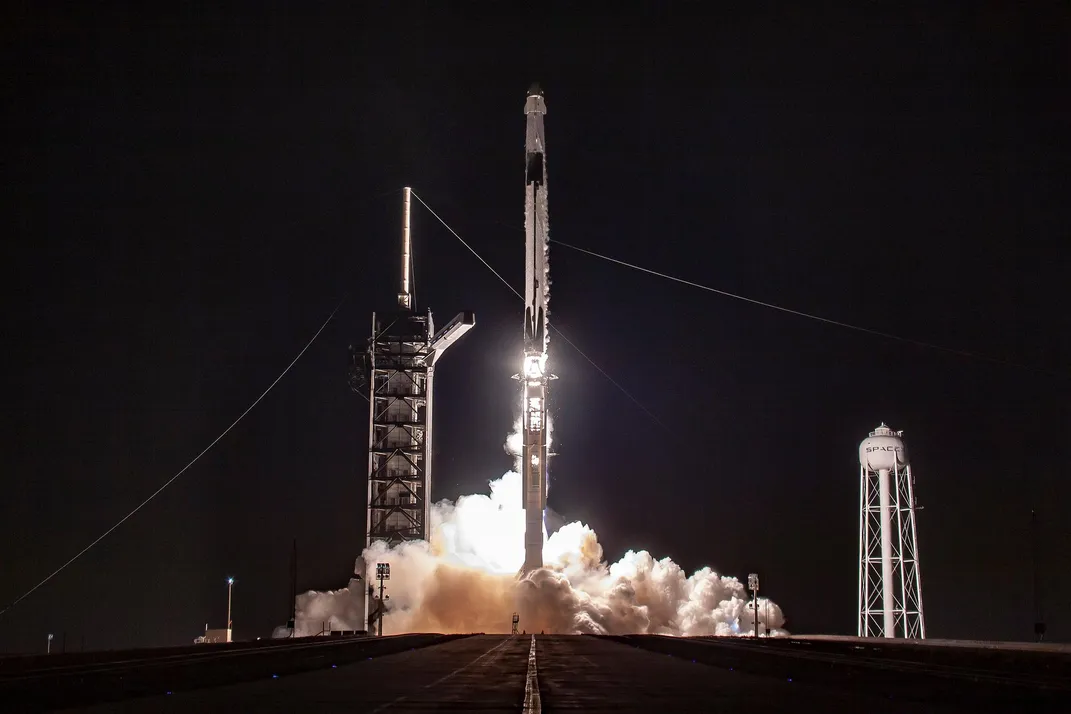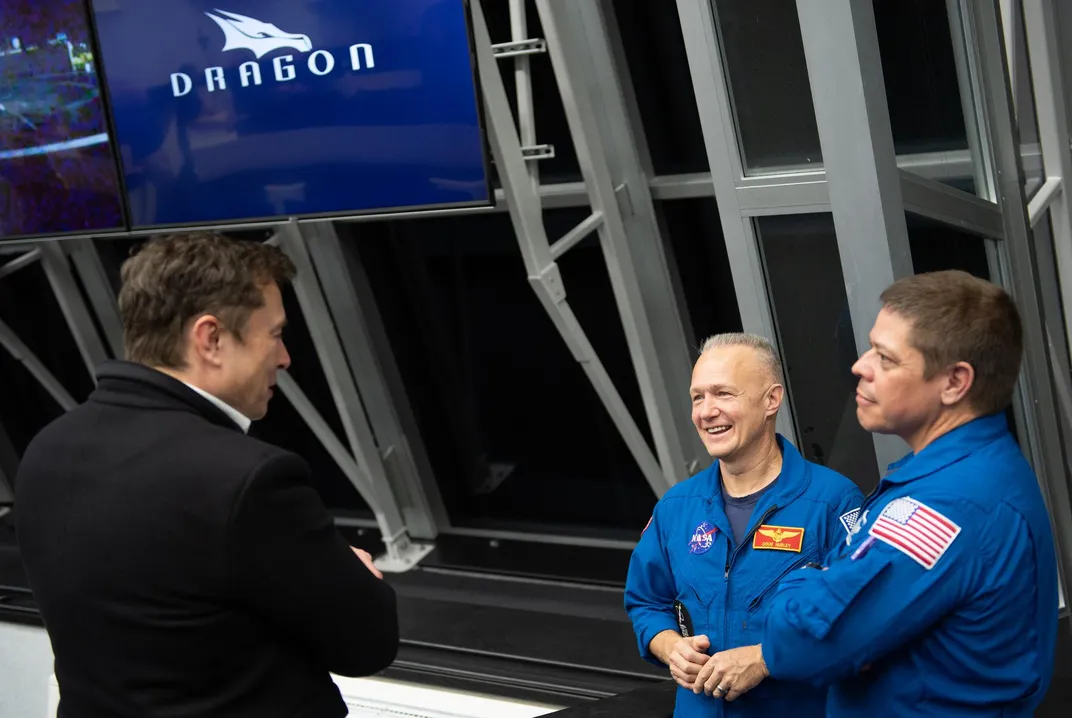After a Successful Test Flight to the International Space Station, SpaceX Looks Ahead to Launching Astronauts
SpaceX’s new Crew Dragon spacecraft could launch the first astronauts from U.S. soil in almost a decade
/https://tf-cmsv2-smithsonianmag-media.s3.amazonaws.com/filer/e4/77/e477f371-b6a2-457f-b275-b9754cdf7c89/d0utuzevyaatojt_1.jpg)
Over the course of the last week, SpaceX took a giant leap toward launching humans from Cape Canaveral for the first time since the end of the space shuttle program in 2011. On Saturday, March 2, at 2:49 a.m. EST, one of the company’s Falcon 9 rockets lit up the pre-dawn sky, lofting a Crew Dragon spacecraft designed to carry humans—but carrying only a stuffed globe and a manikin named Ripley outfitted with a space suit and suite of sensors—to the International Space Station (ISS). SpaceX then landed the Falcon 9 first stage on one of the company’s two drone ships, Of Course I Still Love You, waiting out in the Atlantic.
After a five-day stay at the space station, the Crew Dragon spacecraft undocked and splashed down in the Atlantic Ocean at 8:45 a.m. EST on Friday, March 8. The craft reentered Earth’s atmosphere and then deployed a set of parachutes to slow down and safely land in the ocean where a recovery vessel was waiting to meet it.
The star of the mission, officially known as Demo Mission-1 (DM-1), was an upgraded version of SpaceX’s Dragon spacecraft. Crew Dragon will serve as an astronaut taxi, ferrying people to and from the orbital space station. SpaceX has always intended for its Dragon capsules to transport humans, but every Dragon launched to the ISS so far—16 in all—has carried only cargo.

"Human spaceflight is the core mission of SpaceX, so we are really excited to do this,” Hans Koenigsmann, SpaceX's vice president for build and flight reliability, said on Friday in a pre-launch briefing. “There is nothing more important for us than this endeavor. We really appreciate the opportunity from NASA to really do this and have a chance to fly up to the station.”
The upgraded spacecraft has some shiny new features, including crew life-support systems, seats, control panels and a propulsion system that can be used to keep the crew safe during a launch emergency. But before astronauts can climb aboard, SpaceX has to prove Dragon is ready.
After reaching space, the Crew Dragon spacecraft spent 24 hours chasing the space station. It circled the Earth a total of 18 times, firing its engines to ensure it would be on track for a rendezvous with the orbital outpost. As the capsule neared the station, it completed a series of maneuvers to demonstrate that it could safely approach and retreat from the station—a move the capsule is programmed to carry out to prevent a collision in case of emergencies. (Russia’s space program, wary of the mission risks, ordered the sole cosmonaut on board the ISS, Oleg Kononenko, to remain in the station's Russian segment during the spacecraft’s approach.)
This week’s flight wasn’t the first time that a SpaceX spacecraft has visited the ISS, but it is the first time that one of its capsules docked itself with the orbital outpost. To date, all Dragon cargo craft have instead berthed with the ISS—slowly approaching the space station and waiting for a crew member to grab the ship with a robotic arm. In this case, Crew Dragon’s onboard computers undertook a much riskier maneuver to guide the spacecraft in to dock—a feat that was accomplished just before 6 a.m. EST on Sunday, March 3.
This docking maneuver—a critical part of the test flight—is something the capsule will have to do routinely in the future. "We need to make sure that [Dragon] can safely go rendezvous and dock with the space station, and undock safely, and not pose a hazard to the International Space Station," Kathy Lueders, manager of NASA's Commercial Crew Program, said during the pre-launch briefing.
/https://tf-cmsv2-smithsonianmag-media.s3.amazonaws.com/filer/85/2a/852ab89b-31e5-4a64-83bf-058fa8d28e1c/39684490143_6ca2a58d37_k.jpg)
But perhaps the most daring part of the mission was the Dragon’s final task: reentering Earth’s atmosphere. During Saturday’s post-launch briefing, reporters asked Musk what he was most worried about. “Hypersonic reentry is probably my biggest concern,” he said. Despite being similar to the smooth, cone-shaped Dragon cargo spacecraft, the Crew Dragon version is asymmetrical, which could make it trickier to navigate through the atmosphere while temperatures flair to thousands of degrees Farhenheit.
The odd shape of the Crew Dragon is due to an onboard emergency escape system—a critical feature to ensure the safety of future astronauts during launch. "That [shape] could potentially cause a roll instability on reentry," Musk said. “I think it’s unlikely; we’ve run simulations a thousand times. But this is a possibility."
Despite Musk’s concerns, Crew Dragon aced its fiery descent through the atmosphere and looked in excellent condition as crews prepared to haul it out of the water.
In the past few years, SpaceX has emerged as a preeminent builder of rockets and orbital spacecraft. The California-based aerospace company has not only mastered the difficult task of putting payloads in space—last year SpaceX launched a record 21 times—but the company has made the seemingly impossible task of landing rocket boosters look routine, with 35 successful landings overall. However, SpaceX still has a lot of work to do to achieve its ultimate goal of launching astronauts.
The Crew Dragon capsule is the next big step in SpaceX’s evolution, but it also represents something bigger: NASA’s partnership with the commercial space industry. Following the shuttle program’s end, NASA put its faith in the commercial sector, entrusting two companies, SpaceX and Boeing, to build its future space taxis. Under a contract worth $6.8 billion, these two private ventures have spent the last five years developing spacecraft capable of carrying crew. Their vehicles—SpaceX’s Crew Dragon and Boeing’s CST-100 Starliner—will be NASA’s primary means of transporting astronauts for the foreseeable future, ending almost a decade of reliance on Russia’s space program to launch American astronauts.
NASA currently pays Roscosmos about $80 million per seat to launch astronauts on Soyuz spacecraft. But after this week's SpaceX flight, if post-mission review determines the flight had no issues, we could see astronauts climb aboard the Crew Dragon by the end of the year.

“There’s a lot that we have to do before we can certify both these vehicles to fly humans to space, but I think it’s a definite possibility, and I’m confident we’ll get one of them up there with crew before the end of the year,” Bob Cabana, director of NASA Kennedy Space Center said at the pre-launch news briefing. Following Saturday’s launch, Jim Bridenstine, the NASA administrator, said that he was “100 percent confident” crew would launch this year.
But before that can happen, SpaceX will conduct a different kind of test flight. This time, the same Crew Dragon capsule will initiate an emergency abort shortly after launch, allowing the Dragon to test its onboard escape system. During the test, eight SuperDraco engines attached to the spacecraft's hull will ignite and carry the vehicle away from the rocket. (A similar system on the Russian Soyuz rocket saved two astronauts during a launch failure last October). If everything checks out, the next Crew Dragon spacecraft will carry two NASA astronauts—Doug Hurley and Bob Behnken.
Human spaceflight has typically been the domain of nations, but that is starting to change. With the success of this initial test flight, SpaceX has shown that it's possible for companies and other small enterprises to launch people to space. A new era of human spaceflight is on the horizon, one where astronauts fly in a variety of spacecraft, and private ventures are able to launch people beyond the atmosphere. While this week's flight was a demonstration test, it looks likely that SpaceX will soon be launching people to the ISS and, perhaps eventually, achieve its ultimate goal of sending humans beyond Earth orbit to the moon and on to Mars.